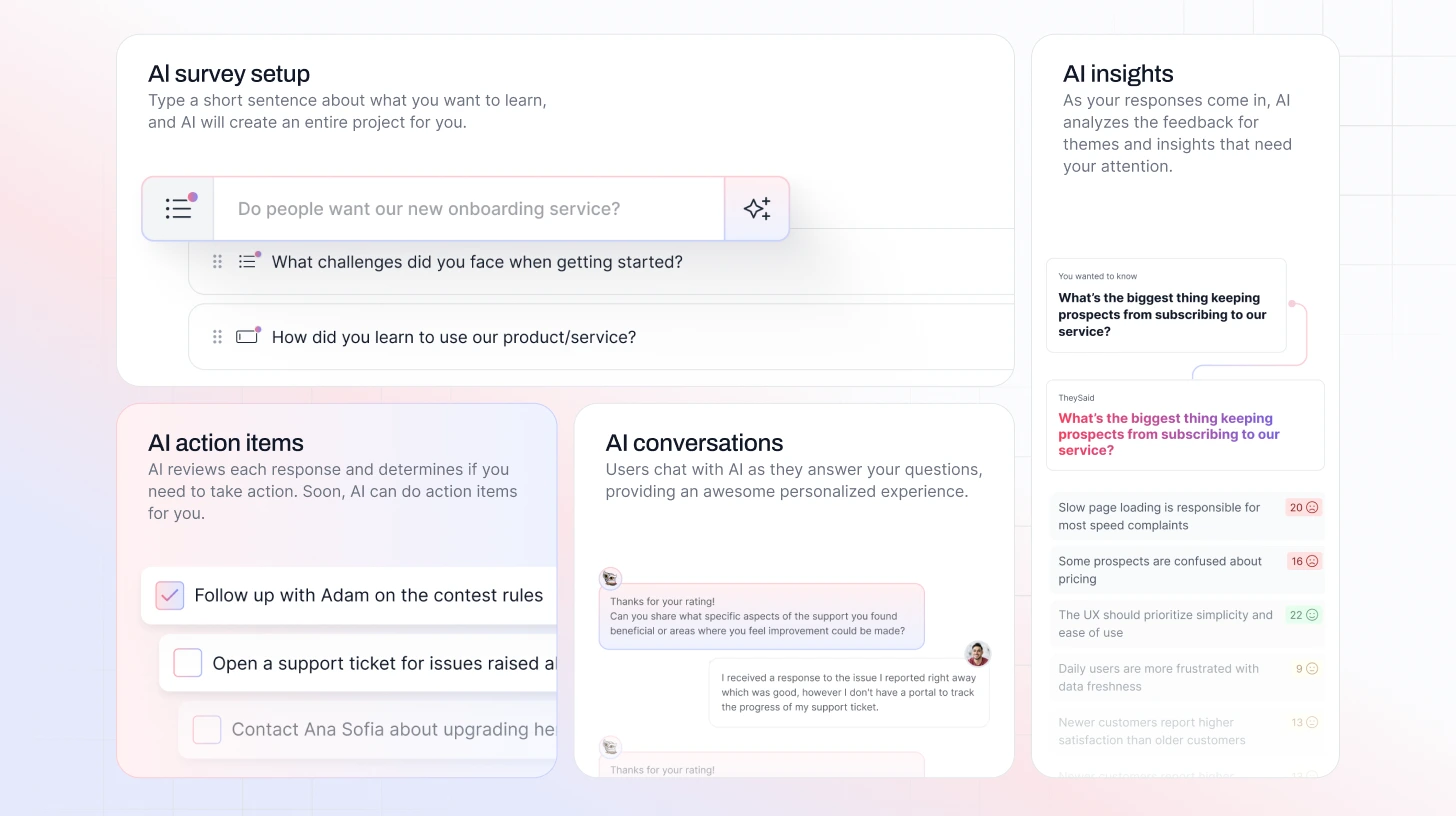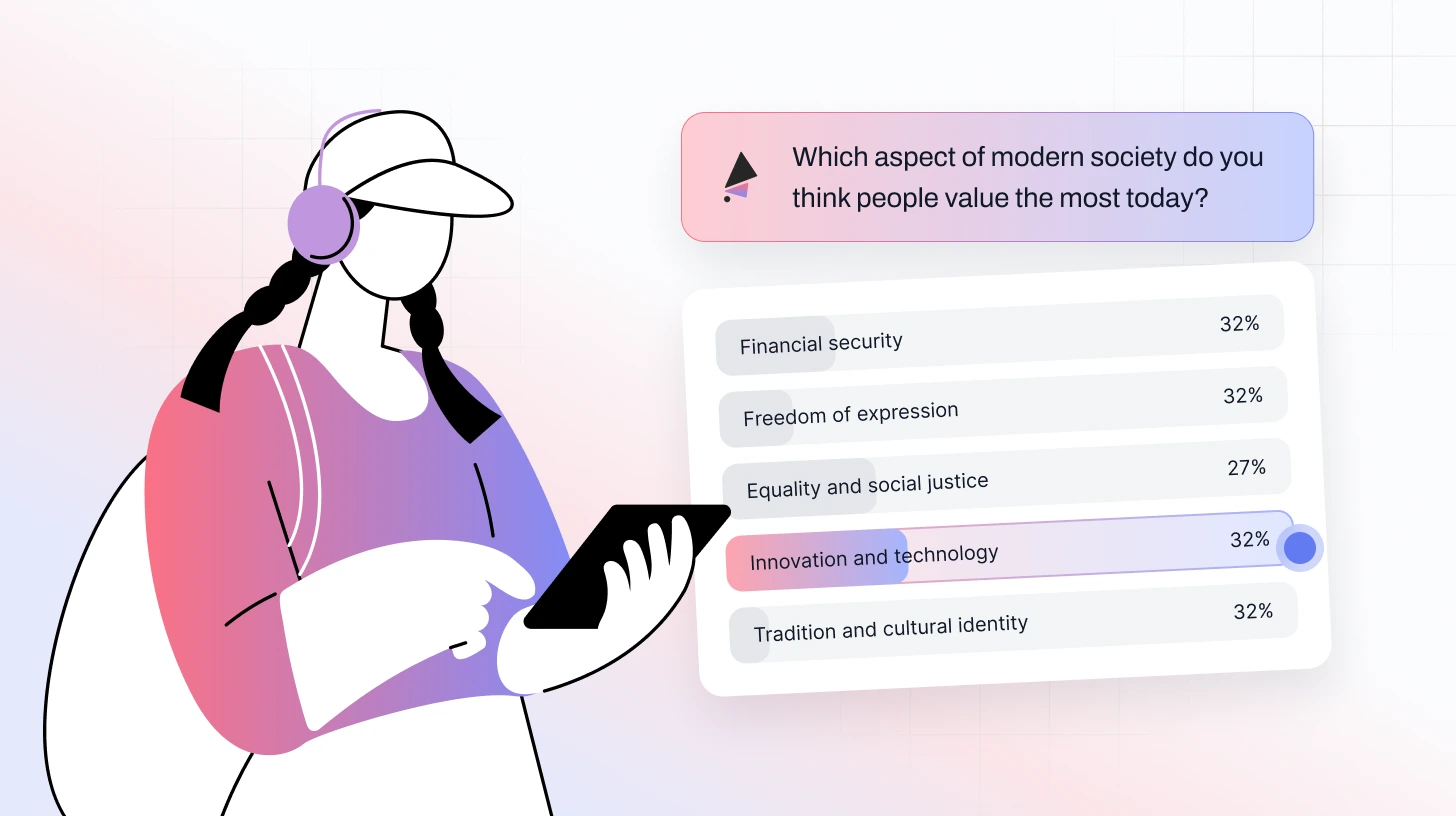 Blog
Blog Employee Voice Survey: Definition, Examples, and Best Practices
Employee Voice Survey: Definition, Examples, and Best Practices Employee Voice Survey: Definition, Examples, and Best Practices

Employee voice is the heartbeat of any organization. It gives your team the power to freely share ideas, concerns, grievances, and suggestions directly with management. At its core, the voice of the employee (VoE) is about making employees feel like they are part of the solution, that their opinions are valued, listened to, and actually influence decision-making.
But here’s the thing…how do you harness this feedback to create real business impact? That’s where Employee voice surveys come in. These tools turn raw insights into actionable strategies that help organizations boost engagement, improve retention, and drive sustainable growth.
Summary
Employee voice is the foundation of an engaged, high-performing workplace. An Employee Voice Survey gives employees a safe space to share ideas, concerns, and experiences, helping leaders understand what’s really happening inside the organization. By combining formal channels (surveys, focus groups, reviews) with informal ones (team chats, discussions), companies get a complete picture of sentiment and engagement.
The impact is measurable: organizations that act on feedback are 3× more likely to hit financial targets, and highly engaged companies see boosts in profitability, productivity, and retention. A strong Employee Voice program improves culture, builds trust, increases productivity, and reduces turnover, especially when employees see real action taken on their input.
Modern platforms like TheySaid elevate this process with AI-powered conversations, real-time insights, and dynamic follow-up questions, making feedback more natural, human, and actionable. The result: higher participation, deeper insights, and faster improvements across teams.
When done well, Employee Voice Surveys turn feedback into action, driving a healthier culture, stronger performance, and meaningful business growth.
What is an Employee Voice Survey?
An employee voice survey is a listening tool that provides a safe space for employees to express their thoughts, feelings, and experiences about their workplace. On the other hand, it allows organizations to understand employee sentiment, uncover pain points, and identify opportunities for improvement across culture, engagement, and performance.
VoE initiatives can be formal or informal, depending on the structure, purpose, and frequency of feedback.
Formal feedback channels: These include organized structural methods such as employee surveys, polls, performance reviews, focus groups, and consultation groups.
In formal feedback channels: These include less structured ways, such as team chats, collaboration tools(Slack, ClickUp), and company discussions.
By combining formal and informal channels, organizations can capture a holistic view of employee engagement and build a continuous listening program. AI-powered platforms like TheySaid can consolidate these inputs, detect patterns, analyze employee sentiment, and surface actionable insights, ensuring no voice goes unheard.

How Employee Voice Surveys Drive Real Business Impact
It’s one thing to roll out a survey; it’s another to measure its value. While putting a dollar figure on a full‑scale Employee voice survey program can be tricky, its return on investment in terms of employee experience, engagement, and organisational outcomes is very real. When employees feel genuinely heard, engage more deeply, and stay longer, the impact ripples through the business.
What the data shows
- Organisations that actively act on feedback from their workforce are 3× more likely to meet or exceed their financial targets than those that don’t. Source
- Companies with high employee engagement report up to 23% greater profitability and around 18% higher productivity than those with low engagement. Source
- In workplaces where employees feel listened to and involved, 74% of them say they are more effective at work. Source
- Globally, only about 21‑23% of employees are fully engaged at work, which suggests a large gap (and large opportunity) for programmes that amplify voice. Source
Employee Voice Survey in Action: Real-World Example
A mid-sized SaaS company with 1,000 employees implemented and conducted an Employee Voice Survey using TheySaid. It gathered open-text feedback every quarter and led to visible leadership action on key themes (for example: faster decision-making, improved role clarity, new internal collaboration tools). The company reported:
The company reported:
- A 15% drop in voluntary turnover among high‑performing staff
- An estimated 12% increase in average employee productivity
- A 10% uplift in its customer satisfaction score, attributed directly to improved employee service delivery
The formula looks something like this: better listening → higher employee satisfaction → stronger engagement → improved customer outcomes → revenue growth. Even if you attribute only part of the gain to the survey program, the ROI is solid.
The Benefits of an Employee Voice Survey
Now that you understand the power of collecting employee feedback, let’s explore what it actually does for your team and your business.
Transparency & Communication Improves Culture
You may have a vision for your company culture, but what about your employees? A well-run Employee voice survey opens up a dialogue and shows you what they really want from their workplace. Listening to your team gives you the chance to shape a culture where people feel valued, safe, and understood. Employees who feel heard are more satisfied, engaged, and committed to the company’s mission.
After a quarterly employee satisfaction survey, a SaaS company learned employees wanted more clarity on career paths. Leadership responded with clear promotion criteria and mentorship programs, creating a continuous listening program and generating actionable employee insights, which improved job satisfaction and engagement.
Recommended Read: Top Employee Satisfaction Survey Tools
Helps Individuals and Teams Grow
When employees know they can speak up, they gain confidence and a sense of ownership over their work. Surveys also reveal where they need support or training, which helps them develop new skills and perform better.
Team dynamics benefit, too. A culture of open communication encourages collaboration, leverages diverse skill sets, and enhances group problem-solving.
A product team shared feedback via an Employee voice survey about roadblocks in collaboration. The leadership implemented cross-team workshops, which improved workflow efficiency and teamwork.
Increases Focus and Productivity
When employees trust that their voice is heard, they can focus more on their work instead of worrying about being ignored. Knowing that concerns will be addressed reduces frustration and distraction, allowing employees to dedicate more energy to impactful tasks.
Customer support agents reported feeling more engaged after surveys highlighted delays in internal approvals, which leadership streamlined, resulting in faster ticket resolution and happier customers.
Improves Retention
Employees stick around when they see their feedback leading to real action. An Employee voice survey signals that leadership cares and that the company is willing to evolve based on employee input.
A SaaS startup discovered high turnover among account managers. Survey results revealed career growth concerns, which prompted mentorship and learning programs. Turnover dropped significantly within a year.
Promotes a Supportive Work Environment
Employee voice surveys are not just about listening; they foster a culture of support. When feedback is acknowledged and acted upon across teams, employees feel safe to speak up anywhere in the business.
A marketing team reported feeling unheard in campaign planning. After acting on survey feedback, managers set up regular check-ins, and employees felt more supported and empowered.
Reduces Negativity, Internally and Externally
When employees feel ignored, frustration and resentment can grow, impacting team morale and even customer interactions. Listening actively helps prevent negative sentiment from festering, keeping teams motivated and customers happy.
A tech company noticed employees sharing frustrations about tool limitations. By implementing feedback-driven changes, the team felt valued, internal tension eased, and the improvements were reflected in better client experiences.

Case Study: Boosting Engagement with an Employee Voice Feedback Tool
Company: A B2B SaaS business (anonymous for confidentiality)
Challenge: The company was struggling with employee engagement and feedback fatigue; annual surveys were low‑response and produced little actionable insight.
Solution: They implemented TheySaid’s conversational AI survey tool to run an Employee voice survey program quarterly. The tool:
- Converted traditional forms into a chat‑style feedback experience
- Asked dynamic follow‑up questions based on employee responses
- Applied AI summarization to surface major themes & action items in real time
Results:
- Response rate improved significantly (from low double‑digits to over 60%)
- The AI analysis identified key root causes of disengagement (e.g., unclear career paths, lack of training feedback)
- As a result, leadership rolled out:
- targeted training & mentorship programs
- a communication campaign on how feedback is used
- a pilot process improvement task force for fast‑moving feedback items
- In the next cycle:
- A drop in voluntary turnover among at‑risk groups
- Improved employee satisfaction scores
- Better alignment of feedback to actionable improvements
Why it worked:
- The chat‑style format felt more human and less survey‑driven, which boosted authenticity.
- Real‑time insights meant leadership could act quickly, reinforcing trust in the process.
- Linking feedback to visible change helped close the loop and improved future participation.
Create your Employee Voice Survey instantly using TheySaid’s free survey generator.
Examples of Employee Voice Survey Questions
The following are some examples of Employee Voice Survey questions. These cover engagement, leadership, career growth, culture, and tools to help capture meaningful feedback from your team.
Employee Engagement and Satisfaction
- How satisfied are you with your current role?
- Do you feel motivated to give your best every day?
- How likely are you to recommend this company as a great place to work?
- Do you feel proud to work here?
Leadership and Management
- Do you feel your manager listens to your ideas and concerns?
- How effective is leadership in communicating company goals?
- Do you trust leadership to make decisions that benefit employees?
- How supported do you feel by your team leader?
Career Growth and Development
- Do you have clear career paths and growth opportunities?
- How satisfied are you with the training and development provided?
- Do you feel you are given opportunities to develop new skills?
- Does leadership provide helpful feedback on your performance?
Workplace Culture and Collaboration
- Do you feel included and respected at work?
- How effective is collaboration across teams?
- Do you feel your opinions are valued in team discussions?
- How well does the company foster innovation and creativity?
Tools and Processes
- Are the tools and technology you use effective for your work?
- How easy is it to get the information you need to do your job?
- Are internal processes clear and efficient?
Open-Ended / Qualitative
- What’s one thing the company could do to improve your experience?
- What’s working well that you’d like to see continue?
- Any challenges or roadblocks you face in your role?
Dos and Don’ts for Voice of Employee (VoE) Program
Implementing a Voice of Employee (VoE) program can transform your workplace, but it’s easy to get it wrong if you’re not careful. Here’s a practical guide for doing it right:
Dos
Do listen and act quickly: Collecting feedback is just the first step. Employees need to see that their voices lead to action. Quick responses, even small ones, build trust and reinforce the value of the program.
Do make it regular and consistent: A one-off survey won’t give you meaningful insights. Use quarterly or pulse surveys to keep a constant finger on the pulse of your workforce. Consistency improves participation and reliability of the data.
Do keep it simple and conversational: Use an Employee voice feedback tool like TheySaid that allows employees to provide feedback naturally, like a chat rather than filling out long forms. It makes the process feel approachable and authentic.
Do close the feedback loop: Always communicate what was heard and what actions will be taken. Employees feel valued when their input leads to real changes, fostering psychological safety at work.
Do use data to inform decisions: Leverage AI, HR data insights, and analytics to detect trends, identify root causes, and prioritize actions. Data-driven insights make your VoE program strategic, not just procedural.
Don’ts
Don’t ignore the feedback: The fastest way to kill trust is to collect opinions and do nothing. Employees will disengage if they feel their voice doesn’t matter.
Don’t overwhelm employees: Avoid survey fatigue by keeping surveys short, relevant, and focused. Too many questions or too frequent surveys can backfire.
Don’t make it one-way: A VoE program should encourage dialogue, not just a form to fill out. Employees should feel safe to ask questions, clarify, and even challenge ideas.
Don’t forget to act across levels: It’s not just about senior leadership. Teams, managers, and individual contributors should all feel empowered to act on feedback. Neglecting any level reduces credibility.
Don’t assume feedback is always negative: Positive feedback matters. Recognize successes, share improvements, and use insights to support employee well-being metrics and reinforce good practices.
Also Read: Why an Employee Wellness Survey Are Essential for a Thriving Workplace
Common Challenges with Employee Voice Surveys
Even the most well-designed Employee Voice Surveys can face challenges. Recognizing these challenges helps you design surveys that employees actually respond to and that leadership can act on.
Low Survey Participation
Employees often skip surveys if they feel their input won’t matter or if the survey is too long. Low response rates can skew results and make the survey less useful.
Tip: Keep surveys short, conversational, and easy to complete. AI-powered tools like TheySaid make surveys feel like natural conversations rather than forms to fill out.
Survey Fatigue
Frequent or overly detailed surveys can overwhelm employees, leading to disengagement. Asking the same questions repeatedly can make the process feel redundant.
Tip: Use pulse surveys or targeted surveys that focus on specific topics. Rotating questions and topics keeps feedback fresh and meaningful.
Lack of Action on Feedback
Collecting survey responses is just step one. If employees don’t see changes based on their feedback, trust in the survey process declines quickly.
Tip: Close the feedback loop. Share results, explain the actions that will be taken, and celebrate even small wins to build credibility and engagement.
Difficulty Turning Feedback into Insights
Raw survey responses, especially open-ended ones, can be overwhelming. It can be hard to identify trends, prioritize issues, and translate responses into actionable steps.
Tip: Use AI-driven analysis in your Employee voice feedback tool to surface trends, highlight critical concerns, and summarize actionable insights in real time.
Resistance from Teams or Leadership
Some managers may worry that surveys invite criticism or create extra work. Without buy-in from leadership, survey results may not lead to meaningful action.
Tip: Educate leaders on the value of surveys: better engagement, improved retention, and stronger culture. Position surveys as tools for improvement, not criticism.
When you anticipate these challenges and use the right approach, Employee Voice Surveys can become a powerful tool for engagement, culture-building, and actionable insights. The right platform, consistent communication, and visible actions turn surveys from a task into a strategic advantage.
Why TheySaid is the Ultimate Employee Voice Feedback Tool
TheySaid is more than a survey tool; it’s a conversation platform for your employees. Traditional surveys often feel robotic, long, or disconnected, which leads to low engagement. TheySaid changes that by combining AI-powered conversations, forms, polls, and user tests in one unified platform, so you can pick the right approach without switching tools or losing context.

Create Personalized, AI-Driven Surveys
- Teach the AI: Upload goals, PDFs, or other resources so the AI understands your company context and survey objectives.
- Templates & Customization: Start with ready-made templates or build your own surveys to match your exact needs.
- Voice Conversations: Employees can speak their answers instead of typing. The AI listens, asks smart follow-ups, skips irrelevant questions, and creates a natural, human-like conversation.
Different Ways to Collect Employee Feedback
- AI Conversations: Great for exploratory feedback, onboarding insights, and engagement checks. Employees type or speak naturally, and the AI adapts dynamically.
- AI Forms: Modern, interactive forms that are engaging and voice-enabled, perfect for structured data collection like NPS or feature requests.
- AI Polls: Go beyond single-choice answers. Collect context behind responses and get summarized insights instantly.
- AI User Tests: Screen recordings and voice narration allow teams to capture usability feedback, prototype testing, and process improvement insights.
Real-Time Insights and Action
- AI summarizes responses instantly, surfacing key themes, trends, and root causes.
- Leaders can ask the AI questions like, “Which onboarding step causes the most drop-off?” and get answers immediately.
- Integration with Slack, Salesforce, HubSpot, Jira, Linear, and Zapier ensures feedback goes directly to the right teams for quick action.
Why It Works
- Higher Participation: The chat-style, conversational experience feels human, not survey-like, which drives engagement.
- Deeper Insights: Dynamic AI follow-ups turn simple ratings into actionable feedback.
- Faster Action: Real-time summaries and integrations mean problems are spotted and resolved quickly.
- Employee Trust: Employees see their input lead to tangible improvements, reinforcing participation in future surveys.
Get started with TheySaid today and transform your Employee Voice Surveys into real-time insights, higher engagement, and measurable business impact.
FAQs
How often should Employee Voice Surveys be conducted?
While annual surveys provide a snapshot, quarterly or pulse surveys are recommended for real-time insights. Frequent surveys help maintain engagement, track trends, and act quickly on feedback.
How can AI improve Employee Voice Surveys?
AI platforms like TheySaid consolidate feedback, perform employee sentiment analysis, detect patterns, and surface actionable insights in real-time, helping organizations act faster and more effectively.
How do you measure the success of an Employee Voice Survey?
Key metrics include survey response rates, employee engagement scores, satisfaction levels, and improvements in retention or productivity. Linking feedback to visible changes reinforces trust and participation.
What is the difference between an Employee Engagement Survey and an Employee Voice Survey?
An Employee Engagement Survey measures how motivated, committed, and satisfied employees feel at work. It usually focuses on engagement drivers like leadership, recognition, workload, and culture.
An Employee Voice Survey, on the other hand, gives employees a platform to openly share ideas, concerns, and feedback. Rather than only measuring engagement levels, it captures what employees want changed, why issues happen, and how the workplace can improve.
















.svg)